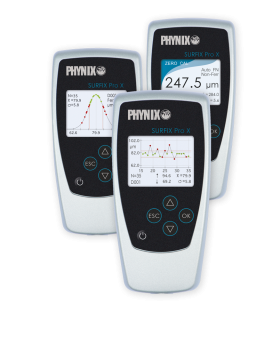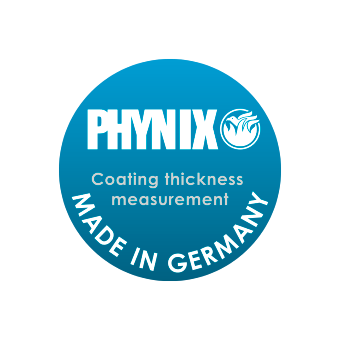Coating thickness measurement: essential measuring method for a wide range of applications
Our heart beats for testing surfaces, especially for coating thickness measurement. In this area, we are one of the world's leading manufacturers and look back on a long and successful history. Our products are exclusively made in Germany. Thanks to the production at our location in Neuss, you benefit from the best quality "made in Germany". PHYNIX - your expert for surfaces.

Precise results thanks to various coating thickness measurement techniques
Coated materials and components are everywhere. Coatings meet functional requirements such as corrosion protection or are used for decorative purposes. Whether varnishing, galvanic layer or multilayer layer structure - a non-destructive coating thickness measurement is needed in nearly all industries. From the plane car paint to the optimally coated screw: Exact coating thickness measurement with PHNYIX gauges ensures perfect results and high customer satisfaction, without damaging the measuring object.

Numerous applications for coating thickness measurement
The reasons why a coating is different are as diverse as the motifs for coating thickness measurement and why it is one of the most indispensable measuring methods in the industry. The following application areas are examples in which an exact measurement of the layer thickness is necessary:
- Test of the delivered material in the goods receipt department. Does the material meet the expected requirements? Is it suitable for the upcoming production process?
- During production: alignment between the production instructions and the real production process. For a perfect result during production manufacturing steps can be adjusted.
- Quality assurance with PHYNIX coating thickness measuring instruments ensures optimal product quality of finished goods.
- Accurate coating thickness measurement simplifies the development of new paint and coating processes and allows the improvement of existing methods
- The coating thickness measurement checks, for example, whether the coating material is used resource-conserving, ensuring adequate protection or a certain dimensional stability is guaranteed. This avoids unnecessary costs and ensures customer satisfaction

Indispensable measuring technology in many industries
The above examples are a selection of where coating thickness measurement should be used. These are used in many different industries and include:
- Metal industry: eg. automotive, railway and steel industry, shipbuilding, aircraft construction and mechanical engineering
- Plastics and chemical industry: tire manufacturers, vulcanization companies and many more
- Galvanic companies: eg. anodizing, chromium plating, galvanizing
- Paint shops, motor vehicle dealers and airlines
- Maintenance and service companies, appraisers, technical testing organizations
- Laboratories and research facilities

Non-destructive coating thickness measurement with various measuring methods
There are several methods which determine the layer thickness. In practice, two measurement methods are widely used for coating thickness measurement, which do not damage either the surface or the underlying individual layers: the magnetic method according to DIN EN ISO 2178 and the eddy current method according to DIN EN ISO 2360.
The base material and the layer to be measured determine the respective method. The magnet method or the magnet-inductive method is used for the coating thickness measurement of nonmagnetic layers on magnetic base material. It is thus suitable for the measurement of lacquers, enamel and plastic on iron or steel. The eddy current method is used to determine the coating thickness of non-conductive basic materials on nonmagnetic material. This method is suitable for measurement layers like lacquers, rubber, plastic as well as ceramics on aluminum, copper, brass or zinc die casting.
Both surface measurement techniques have the great advantage that they determine the coating thickness non-destructive. In contrast to other methods such as the peeling method, they do not damage the surface of the object.

How it works: Functionality of probes and sensors and the different measurement principles
The magnetic induction method and eddy current methods differ in their mode of operation. In the magnet method, low-frequency alternating current, a magnet coil and a measuring coil are used. The layer thickness measuring device evaluates the measured winding voltage electronically and displays the exact value digitally. In the eddy current method, high-frequency alternating current flows through a coil and produces an eddy current that affects the coil inductance. The PHYNIX coating thickness measuring devices process the measured inductance and display the layer thickness on their displays.
Combination probes combine the different modes of operation and are thus versatile. Both measuring methods require an undisturbed course of the magnetic field lines. However, this is not the case with curved surfaces or at edges. The coating thickness measurement on soft or rough surfaces can cause difficulties. A calibration of the measuring device is necessary for these special measuring tasks.

Different calibration methods for exact coating thickness measurement
PHYNIX's high-quality PHYNIX coating thickness gauges are adjusted in the factory in such a way that they precisely measure and display the coating thickness of a flat surface - a calibration is not necessary. In the case of the above-specified special measurement tasks, a calibration is unavoidable, since otherwise the measurement results would be not accurate. For an optimum setting of the coating thickness gauge there are different calibration methods available: one-point calibration, two-point calibration and two-foil calibration ensure precise coating thickness measurement.
PHYNIX: Your competent partner for coating thickness and surface measurement
In addition to our coating thickness gauges, our portfolio also includes products for surface measurement: from porosity detection and hardness testing through gloss measurement and cross-hatch cutting as well as wall thickness and roughness measurement - the surface measuring devices from PHYNIX meet the highest quality standards.

News
New company name PHYNIX Sensortechnik GmbH
Effective as of January 1st, 2022 Phynix GmbH & Co. KG will be merged with its parent company, ppm Sensortechnik GmbH to the new PYHNIX Sensortechnik GmbH
Cookies help us to run this website. By using this website you agree that we are using cookies for tracking and improvement.


